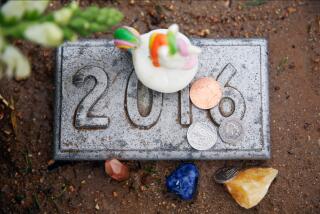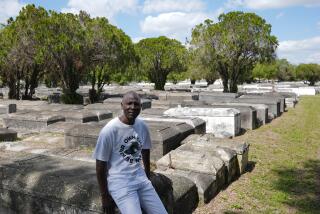Between the sacred and the mundane
The first step when digging a grave at Mountain View Cemetery is to measure the plot and calculate the spacing. Scraping an adjacent casket or a vault is bad form; rupturing a sprinkler line is even worse.
The second step is to cut and remove the sod. Then it’s time to start up the backhoe.
Sammy Treto keys the ignition, makes the sign of the cross — as he usually does — and wheels the lumbering machine out of the utility yard. It’s just after 6:30 in the morning. A rooster calls in the distance.
On days when there are burials, Treto likes to start early. He doesn’t want to draw attention to the process, the slow carving of this shadowy hole, and when the family shows up, he wants the grave to be draped with Astroturf, the vault prepared, the chairs neatly arranged in the shade of a tree.
Treto, 54, is one of eight men responsible for the care of the cemetery’s grounds. Others mow lawns, sweep buildings and clean fountains; he handles the disposition of the dead and arranges the seasonal color, pansies and snapdragons in the winter, marigolds and zinnias in the summer.
As soon as he finishes with the grave, he will return to work on a new garden he’s planting at an outdoor mausoleum across the street. He’s bought the camellias, roses and lavender, and he’s rototilled the soil. He’s proud of his landscaping and knows that visitors appreciate it as well.
Photos: Cemetery grounds keepers
When families first arrive at the cemetery in the foothills of Altadena, they are often numb, and as Treto and the grounds crew watch them from afar, they hope that the beauty of these grounds will ease the sorrow.
Treto positions the backhoe over a narrow strip of grass between a sidewalk and a parking lot. The sun clears the crest of the San Gabriel Mountains to the east. Its light rakes across the lawns, turning their muted color brilliant green. Long shadows fall from the monuments and trees. Birds are loud, almost cacophonous.
He extends the backhoe’s bucket and takes the first cut out of the dirt.
When he began at Mountain View 25 years ago, he was apprehensive about working in a cemetery, but he soon learned he needn’t worry about the dead. It was the living who affected him the most.
They’d approach when they needed directions. They’d ask for help in placing flowers. They’d complain when something wasn’t right, and they’d tell him their stories, leaving him to imagine how fast his life could change. At night when he got home, he’d hold onto his children until they’d squirm away.
“When I started working here, I was really emotional,” he says. “But you learn how to survive these emotions.”
Radiant meadow
Spring and summer are busy times of the year at Mountain View, and the grounds crew has fanned out through a section called Radiant Meadow.
Two weeks have passed since they last mowed here. String trimmers whip at the kikuyu grass that grows across grave markers. Dandelions and dirt fly up from the bases of monuments.
Brian Roberts, 40, props his Weed Eater against a headstone and wipes the sweat from his brow. He started at the cemetery when he was a teenager. His father, who also works here, encouraged him to apply, and nearly 25 year later, Roberts has worked his way up to foreman.
He stoops to flag one marker that’s settled at a sharp angle. He will come back in the afternoon to level it.
His day often begins with a tour of the 60 acres to see if anything is amiss: a fallen tree limb, a broken sprinkler, evidence of after-hour reveries or something darker. Dead chickens and cow tongues have been found.
He knows the dimensions of a grave — 8 feet by 38 inches by 7½ feet deep — and he can fire up the furnace in the crematory, and when talking about working in the company of the bereaved, he is more pragmatic than philosophical.
“You tell yourself that this is part of life, and someone has to do this work,” he says. “That’s what me and my dad have been doing for all these years.”
Photos: Cemetery grounds keepers
There was a time when cemeteries didn’t have grounds crews, when graveyards, lying crowded and cluttered near the center of cities, were mere depositories for the dead. The emergence of “garden cemeteries” in the 19th century changed that, just at the time Mountain View opened.
The year was 1882, and the residents of Pasadena decided that burials on private property, which had been the custom, might not be appropriate for a city hoping to attract new residents. A landowner in Altadena offered some acreage. Soon obelisks, statues and private mausoleums arose beneath a broad canopy of trees.
Since high school, Roberts has stopped among these monuments, calculated ages and read the remembrances. Comparisons are inevitable. It’s what everyone does, only Roberts does it more often and sometimes from the seat of a lawnmower.
Although Mountain View has its share of the famous — actor George Reeves, activist Eldridge Cleaver, physicist Richard Feynman — Roberts finds the more eloquent deaths to be those less shadowed by fame.
Gilda Marisol Martinez
Dec. 19, 1978 to Feb. 14, 1995
From your parents with love to our beloved daughter
He still remembers her story, how she had gone to a Valentine’s party that was crashed by four boys carrying guns. She was 16, and all her friends went to her funeral. Whenever he looks at her grave, he thinks about his own daughter, who was 3 at the time.
The lesson is inescapable. The ideal death — at home, asleep, in old age — is the rare death.
‘No happiness’
Later that morning in the new garden, Treto pauses to study the arrangement of the lavenders, nearly 40 plants spread out to one side of a sundial.
Treto’s first job at the cemetery was in the old mausoleum, where he would mop the marble floors, keep pigeons from roosting above the stained-glass windows and place ashes and bodies in the niches and crypts. He remembers how his boss used to walk the long hallways in stocking feet to make sure the floors were clean. She now lies in one of the upstairs galleries.
Eventually, Treto was assigned to the crematory but lasted only three weeks. The job made him uncomfortable. He then learned how to drive the backhoe, practicing on a pile of dirt displaced by burials and stored in a side yard.
Video: Cemetery grounds keepers
When he was asked to interview workers to fill an opening a few years ago, most declined after learning where they’d be working. He has relatives who wonder if you can get sick from the dead. He understands their concerns.
“There is no happiness here,” he says. “There is no reason to be happy when you say goodbye to a loved one.”
He takes the plants out of their plastic containers. This garden is important to him. On the mausoleum’s terrace overhead is a friend who died in an automobile accident four years ago. From the nameplate on his crypt, Treto has hung a rosary and the image of the Virgin of Guadalupe.
Treto believes in the Resurrection, and when he thinks about joining those he’s lost, he tears up. It is easier to talk about the preparations.
Not long ago, he bought a plot in the Founder’s Lawn, angled against the curb and near an oak. He excavated it and with the backhoe, lowered into the space the vault that will one day hold the caskets for himself and his wife.
“I dug my own grave,” he says, aware of how strange it might sound to someone who doesn’t understand this work.
‘Follow me’
Willie Roberts, Brian’s father, sits atop a lawnmower, cutting broad swaths of grass.
He’s 61 and has put in 43 years. He plans to be here after his death too. His niche, shaded by a tall Chinese elm, is in an outdoor mausoleum beside his mother, two brothers and an uncle. He wants to be cremated; lying underground — in the cold and the damp — makes him uneasy.
“It’s hard to imagine yourself gone,” he says, “but it’s comforting knowing where your spot is.”
Video: Cemetery grounds keepers
When he was younger, he once came upon the grave of Mrs. J.K. Hearte, lying beneath a liquidambar tree. She died in 1924. He always liked reading the inscription on her monument:
As you are now, so once was I. As I am now, so you must be — prepare for death and follow me.
He wonders how he will be remembered. A good husband and father? That would be for his family to say. He likes “Mountain View employee.”
In the distance beyond a row of stately deodar trees, a visitor parks in the shade and collects water from a spigot before leaving an arrangement. Roberts knows that no matter the beauty of these grounds, these visits become less frequent with each week, each month and year.
Graves, once marked with the comings and goings of families — fresh flowers or a Mylar birthday balloon — will be indistinguishable from the 90,000 others.
The dead are destined to be forgotten. Maybe not in this generation, maybe not in the next, but eventually they become just a name and a date.
More to Read
Start your day right
Sign up for Essential California for news, features and recommendations from the L.A. Times and beyond in your inbox six days a week.
You may occasionally receive promotional content from the Los Angeles Times.







